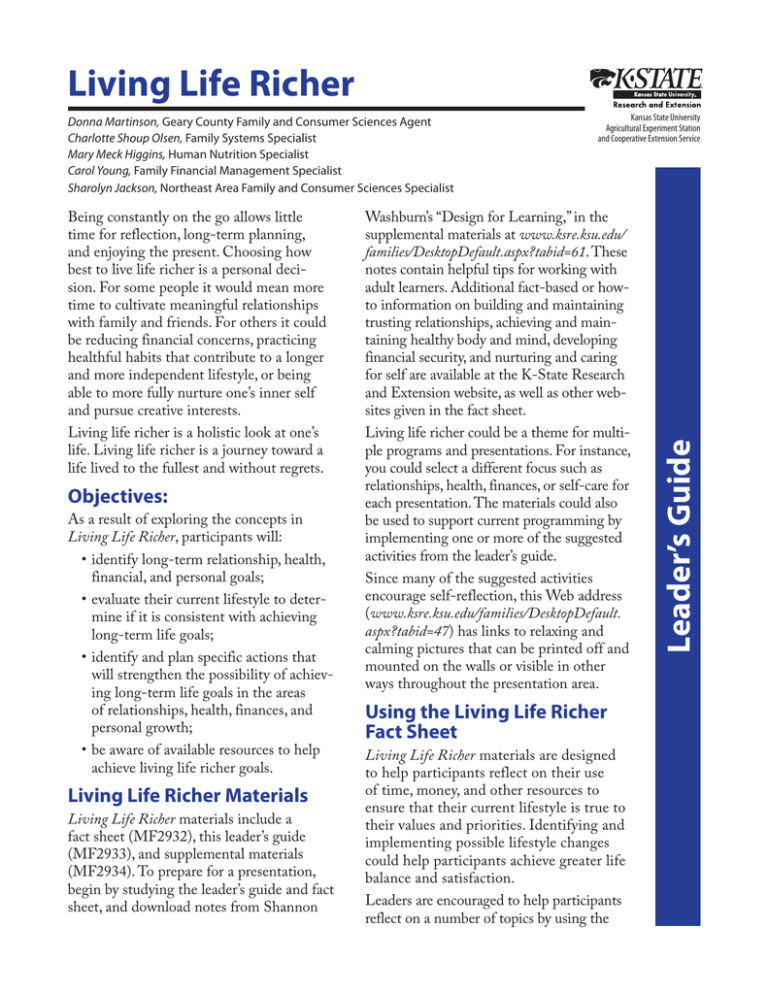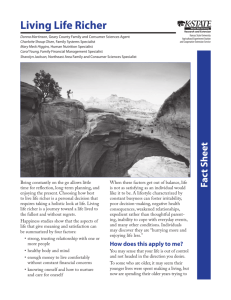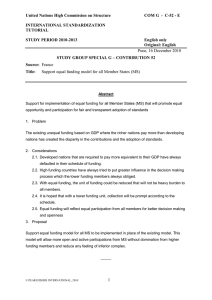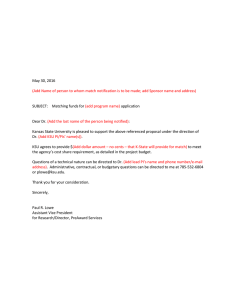
Living Life Richer
Being constantly on the go allows little
time for reflection, long-term planning,
and enjoying the present. Choosing how
best to live life richer is a personal decision. For some people it would mean more
time to cultivate meaningful relationships
with family and friends. For others it could
be reducing financial concerns, practicing
healthful habits that contribute to a longer
and more independent lifestyle, or being
able to more fully nurture one’s inner self
and pursue creative interests.
Living life richer is a holistic look at one’s
life. Living life richer is a journey toward a
life lived to the fullest and without regrets.
Objectives:
As a result of exploring the concepts in
Living Life Richer, participants will:
•identify long-term relationship, health,
financial, and personal goals;
•evaluate their current lifestyle to determine if it is consistent with achieving
long-term life goals;
•identify and plan specific actions that
will strengthen the possibility of achieving long-term life goals in the areas
of relationships, health, finances, and
personal growth;
•be aware of available resources to help
achieve living life richer goals.
Living Life Richer Materials
Living Life Richer materials include a
fact sheet (MF2932), this leader’s guide
(MF2933), and supplemental materials
(MF2934). To prepare for a presentation,
begin by studying the leader’s guide and fact
sheet, and download notes from Shannon
Kansas State University
Agricultural Experiment Station
and Cooperative Extension Service
Washburn’s “Design for Learning,” in the
supplemental materials at www.ksre.ksu.edu/
families/DesktopDefault.aspx?tabid=61. These
notes contain helpful tips for working with
adult learners. Additional fact-based or howto information on building and maintaining
trusting relationships, achieving and maintaining healthy body and mind, developing
financial security, and nurturing and caring
for self are available at the K-State Research
and Extension website, as well as other websites given in the fact sheet.
Living life richer could be a theme for multiple programs and presentations. For instance,
you could select a different focus such as
relationships, health, finances, or self-care for
each presentation. The materials could also
be used to support current programming by
implementing one or more of the suggested
activities from the leader’s guide.
Since many of the suggested activities
encourage self-reflection, this Web address
(www.ksre.ksu.edu/families/DesktopDefault.
aspx?tabid=47) has links to relaxing and
calming pictures that can be printed off and
mounted on the walls or visible in other
ways throughout the presentation area.
Using the Living Life Richer
Fact Sheet
Living Life Richer materials are designed
to help participants reflect on their use
of time, money, and other resources to
ensure that their current lifestyle is true to
their values and priorities. Identifying and
implementing possible lifestyle changes
could help participants achieve greater life
balance and satisfaction.
Leaders are encouraged to help participants
reflect on a number of topics by using the
Leader’s Guide
Donna Martinson, Geary County Family and Consumer Sciences Agent
Charlotte Shoup Olsen, Family Systems Specialist
Mary Meck Higgins, Human Nutrition Specialist
Carol Young, Family Financial Management Specialist
Sharolyn Jackson, Northeast Area Family and Consumer Sciences Specialist
scenarios and questions given in the section “How does this apply to me?” After
introducing a scenario, ask participants to jot
down their thoughts and give them time to
do so. Provide paper, if needed. Invite participants to share their answers in pairs. Then
ask for one or two volunteers to share with
the whole group. Be nonjudgmental when
discussing responses since living life richer is
individually defined.
Target Audiences
2
With slight adaptations Living Life Richer
can be used to help the following audiences:
•Parents of young children: Identify
parenting practices that will help children develop skills and confidence
needed to make physically and emotionally healthful decisions.
•Parents of school-age children and
teens: Prioritize activities that support
children’s academic achievement, the
exploration of children’s interests and
development of skills, and the development of supportive relationships at
school, church, in the neighborhood,
and in the family.
•Youth (school-age through college):
Identify and evaluate actions and
attitudes that will help them achieve
their goals, such as independence,
a well-paying job, opportunities to
explore interests, and positive personal
relationships.
•Adults: Evaluate current lifestyle to
determine if changes are needed to
achieve life goals, such as to strengthen
relationships, increase financial security,
adopt health-contributing practices, and
pursue personal interests.
•Older adults: Encourage reflection
on life experiences and practices that
enriched their lives; discuss how life
lessons could be shared with younger
people in a positive way; explore ways
they can continue to keep their minds
and bodies active.
Suggested Activities
A wide array of activities is suggested,
based on the audience and participant
needs. Each bulleted item could be a
stand-alone lesson, depending on the
time available and the leader’s knowledge
and expertise with the given subject area.
Consult the fact sheet for websites for each
of the following content areas to become
more familiar with current information.
•Discuss current trends that have emerged
in an attempt to establish a more satisfying balance of life’s demands, such as the
Slowness Movement (aims to address
the issue of “time poverty” through making connections between family, work,
and community), Intentional Harmony
(evaluating decisions and actions by
first asking how the decision or action
will contribute to building harmony in
one’s personal and work life), Slow Food
(movement away from hurriedly prepared or purchased meals that contribute
to health problems and are deficient in
health-protective foods; also includes
less hurried mealtimes to allow more
time for meal consumption and personal
interactions); happiness research (studies
conducted in various cultures on what
contributes to an individual’s long-term
happiness), and others.
•On a large sheet of paper or a markerboard, have parents list attributes
they would like their children to have
when they become adults, then identify
child-rearing and other practices to use
now that will develop those attributes.
Discuss parents’ influence as models for
living life richer.
•Help your audience identify and discuss
their levels of readiness to change some
specific aspect of their lives so that
they might live life richer. Researchers
who study behavior change have identified five levels of readiness for changing a behavior, as shown in Table 1.
Use an example of a specific behavior,
such as increasing the amount of daily
physical activity, to illustrate how
the continuum can help individuals
identify their readiness for change.
(Readiness for Change Continuum
worksheet may be found in the Living
Life Richer Supplemental Materials,
MF2934.) What barriers might they
face along the continuum? How could
they overcome these obstacles?
•Place living life richer statements such
as “Hold hands with a loved one,” “Be
trustworthy,” or “Watch a sunset or
sunrise” in a container and have participants draw out a statement. Have the
participant read and then discuss how
such a practice might help a person to
live a richer life. Invite other participants to offer comments. Encourage
positive comments and have fun with
the discussion. Additional living life
richer statements may be downloaded
at www.ksre.ksu.edu/families/DesktopDefault.aspx?tabid=61.
•Have participants think of someone
they know who appears to live a rich,
full life. Ask, “What do these individuals do that seems to help them live life
richer?” Then share and discuss answers.
What attitudes or actions are identified
that each participant could include in
his or her life to live life richer?
•Introduce participants to the concept
of locus of control, which refers to the
extent people perceive how their personal behavior influences life events. (See
Small Steps to Health and Wealth, listed
in the fact sheet references, for more
information.) People with an internal
locus of control perceive themselves
as having control over the outcome
of events, including their health and
finances. They believe that responsibility
for outcomes is based, at least partially,
on their personal actions. Those who
have an external locus of control perceive
things to happen by luck, fate, or the
control of powerful people. Life is seen
as a game of chance where “whatever
will be, will be.” Discuss how a person’s
concept of locus of control might influence goals to live a richer life.
•Discuss the differences between using
time effectively and using it efficiently.
Effective time use means that time is
being invested in a way that will garner
the greatest payoff toward the achievement of long-term goals. Efficient
time use means that multiple tasks are
accomplished in as little time as possible, but the tasks are not necessarily
ones that are critical to the achievement of long-term goals. To set priorities, determine if tasks are important
and urgent; important, but not urgent;
urgent, but unimportant; or neither
urgent nor important.
•Use an Audience Response System
(“clickers”) to involve participants and
for program evaluation. Some possible
statements/questions that could be used
include True or False statements such
as “I currently devote as much time and
attention to relationships with family
and friends as I’d like” or “My eating
and physical activity habits will help me
Table 1. The Continuum of Readiness to Change a Specific Behavior
Goal 1: _____________________ (example: be physically active at least 30 minutes 5 days a week
1
Not ready or
intending
to change
2
Intend
to change later
3
Intend to change
in the next
30 days
4
Have made
some changes,
need support
to keep going
5
Changes have
been made
and can be
maintained
3
live a long, healthy life.” More audience
response system suggestions may be
found in the Living Life Richer Supplemental Materials, MF2934. (Audience
Response systems are available from the
area offices.)
•Have participants compose a Haiku
(pronounced HI-coo) poem related to
Living Life Richer. Haiku is a poetic
form from Japanese culture. See Living
Life Richer supplemental materials for
additional information on Haiku and/or
find more information at http://volweb.
utk.edu/school/bedford/harrisms/haiku.htm
•Possible roll calls: Practices that would
help reduce constant financial concerns;
a way that I let those I love know I love
them; why maintaining good health is
important to me; one way I take care
of my mental health is to ______; what
“living life richer” means to me; to live
life richer I can _______.
Resources
See list on the Living Life Richer Fact Sheet,
MF2932.
Supplemental materials: MF2934 Living
Life Richer Supplemental Materials, which
includes Utilizing an Audience Response
System, Readiness for Change Continuum,
Haiku Poetry, and Living Life Richer
Evaluation
Material to download from the Families
website (www.ksre.ksu.edu/families/
DesktopDefault.aspx?tabid=61):
Living Life Richer Statements and Quotes
Living Life Richer Suggestions for Adult
Educators (Shannon Washburn’s presentation from Design for Learning series:
www.ksre.ksu.edu/Employee_Resources/DesktopDefault.aspx?tabid=300
Dr. Washburn’s presentation is Session 3:
“Transfer of Learning.”)
Living Life Richer Contemplation Photos
Authors
Donna R. Martinson, Geary County Family and
Consumer Sciences Agent, retired; dmartins@ksu.edu
Charlotte Shoup Olsen, Family Systems Specialist,
Family Studies and Human Services, colsen@ksu.edu
Mary Meck Higgins, Human Nutrition Specialist,
mhiggins@ksu.edu
Carol Young, Family Financial Management
Specialist, cyoung@ksu.edu
Sharolyn Jackson, Northeast Area Family and
Consumer Sciences Specialist, sharolyn@ksu.edu
Consultant: Elaine Johannes, Youth Development
Specialist, ejohanne@ksu.edu
Reviewers
Susie Latta, Marshall County Family and Consumer
Sciences Agent
Tara Solomon, Neosho County Family and
Consumer Sciences Agent
Brand names appearing in this publication are for product identification purposes only. No endorsement is intended, nor is criticism implied of similar products not mentioned.
Publications from Kansas State University are available on the World Wide Web at: www.ksre.ksu.edu
Publications are reviewed or revised annually by appropriate faculty to reflect current research and practice. Date shown is that of publication or last revision.
Contents of this publication may be freely reproduced for educational purposes. All other rights reserved.
In each case, credit Donna Martinson, et al., Living Life Richer, Leader’s Guide, Kansas State University, August 2010.
4
Kansas State University Agricultural Experiment Station and Cooperative Extension Service
MF2933 August 2010
K-State Research and Extension is an equal opportunity provider and employer. Issued in furtherance of Cooperative Extension Work, Acts of May 8 and June 30, 1914, as amended.
Kansas State University, County Extension Councils, Extension Districts, and United States Department of Agriculture Cooperating, Gary Pierzynski, Interim Director.




